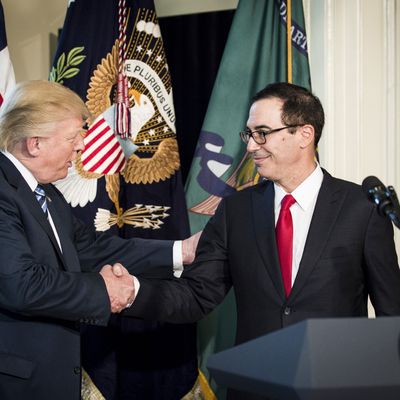
The Trump administration has proven incapable of drafting budget proposals free of multi-trillion-dollar math errors. Congressional Republicans are struggling to find the votes necessary to keep the U.S. from defaulting on its debt.
And yet, they’re both pretty sure that they can pass the largest tax cut in U.S. history — as part of the first comprehensive tax-reform package in more than three decades.
Or at least, that’s what Paul Ryan, Mitch McConnell, Gary Cohn, and Steve Mnuchin would like the public to believe.
Their official confidence is hard to square with various political realities, and not just the ones already cited. The Trump administration took office with tax reform as its single policy-making priority, having delegated Obamacare repeal to Congress. And yet, six months into its tenure, the White House’s only official tax-reform plan has been a bullet-point list of radically regressive tax cuts — a proposal that was, in essence, a less detailed version of the plan Trump had campaigned on in 2016. The administration’s primary proposal for defraying the cost of its tax cuts — which some have estimated at over $7 trillion for their first ten years — was to close unspecified “special interest” loopholes.
Meanwhile, congressional Republicans’ best ideas for offsetting the cost of tax cuts — a border-adjustment tax and Obamacare repeal — are dead or on life support, respectively.
The GOP needs to pass its tax agenda using budget reconciliation — a special legislative process that makes it possible to pass fiscal bills with a mere 50 votes in the Senate, so long as said bills don’t increase the deficit ten years after they’re passed. Which is to say: If they can’t offset their tax cuts, they can’t pass permanent reform.
And as of this writing, it’s unclear whether Paul Ryan’s caucus can even find consensus on the prerequisite for any reconciliation bill, a 2018 budget resolution.
Given all this, the Trump administration’s best move would probably be to stop kidding itself; pick two or three of its most politically palatable tax-cut ideas; and pass them on a temporary basis, with no offsets.
Surprisingly, two of the White House’s favorite high priests of supply-side voodoo — Stephen Moore and Larry Kudlow — are encouraging Trump to pursue this eminently rational course of action. As the Washington Post reports:
The plan for a more narrow tax cut, which officials could begin pursuing as soon as September, is a recognition of the challenges the broader overhaul faces, with the Republican Party struggling to find consensus on key parts of tax reform.
The top advocates for the targeted tax cut have been Larry Kudlow and Steve Moore, who were both top economic advisers during Trump’s campaign and remain in frequent contact with officials in the West Wing.
Kudlow met with top [National Economic Council] staffers two weeks ago and also had a private meeting with Trump, in which he urged them to consider pursuing tax cuts this year if they are unable to marshal agreement on a broader change to the tax code.
… Kudlow and Moore have been pitching a plan they call “Three Easy Pieces,” which would — for 10 years — cut the corporate tax rate from 35 percent to 15 percent, double the standardized deduction that millions of Americans claim in their taxes, and allow companies to bring money back from overseas without a significant tax penalty.
It’s highly doubtful that Trump can get the corporate rate down to 15 percent — a reduction that would cost the government roughly $2 trillion over the next decade. But a more modest reduction in the corporate rate; an increase in the standard deduction that would genuinely help some middle-income families; and a tax holiday encouraging companies to repatriate their earnings all seem politically tenable.
And together, they’d likely accomplish most of Trump’s core goals for tax “reform”: a marketable, legislative “win,” and short-term economic stimulus that could buoy the GOP in next year’s midterms and/or aid his 2020 reelection effort.
Paul Ryan may have his heart set on enacting “once in a generation,” permanent reforms to the tax code. Mick Mulvaney might wish to balance the federal budget.
But Trump just wants to win. And he’ll have a better shot at doing that if he turns down the difficulty setting on his legislative agenda.






























